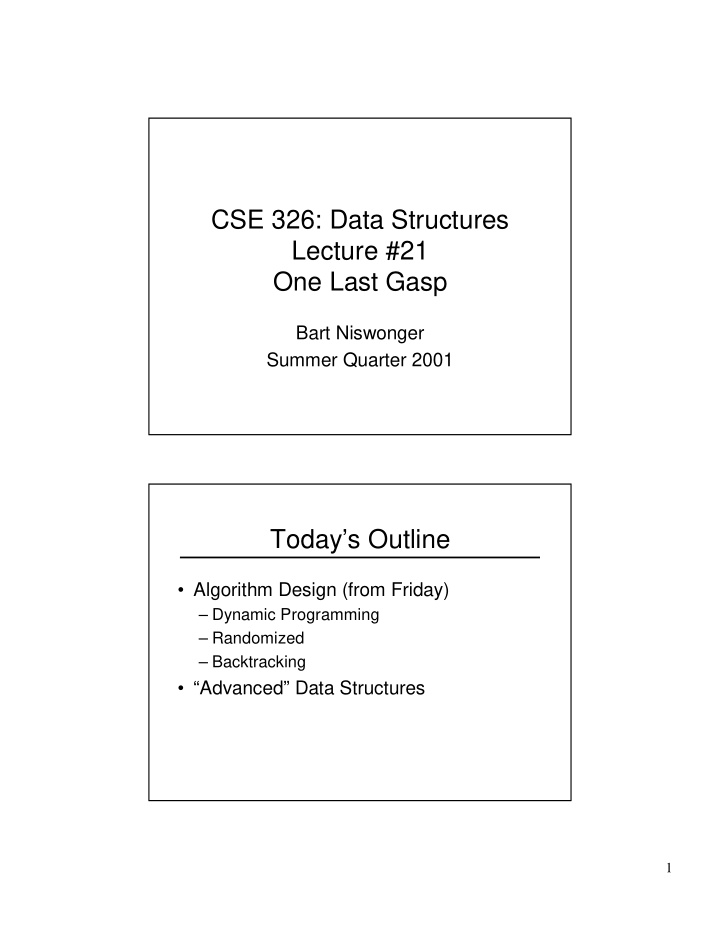



CSE�326:�Data�Structures Lecture�#21 One�Last�Gasp Bart�Niswonger Summer�Quarter�2001 Today’s�Outline • Algorithm�Design�(from�Friday) – Dynamic�Programming – Randomized – Backtracking • “Advanced”�Data�Structures 1
Treap�Dictionary�Data�Structure heap�in�yellow;�search�tree�in�blue • Treaps have�the� binary�search�tree 2 9 – binary�tree�property – search�tree�property 6 4 • Treaps�also�have�the� 7 18 heap-order�property! – randomly�assigned� 7 9 10 priorities 8 15 30 Legend: 15 priority key 12 Tree�+�Heap…�Why�Bother? Insert�data�in�sorted�order�into�a�treap;� what�shape�tree�comes�out? insert(7) insert(8) insert(9) insert(12) 6 6 2 2 7 7 9 9 7 6 6 15 8 7 7 12 Legend: 7 7 priority key 8 8 2
Treap�Insert • Choose�a�random�priority • Insert�as�in�normal�BST • Rotate�up�until�heap�order�is�restored insert(15) 2 2 2 9 9 9 6 15 6 15 6 9 7 12 7 12 7 15 7 7 9 7 15 8 8 15 8 12 Treap�Delete 6 • Find�the�key 2 �� 7 9 • Increase�its�value�to� 7 � 6 9 � 8 9 7 15 • Rotate�it�to�the�fringe 9 7 15 • Snip�it�off 15 8 12 6 6 15 7 7 6 12 7 9 7 9 7 8 15 8 15 7 9 15 � 8 15 9 12 15 15 � delete(9) 12 12 9 3
Treap�Summary • Implements�Dictionary�ADT – insert�in�expected�O(log�n)�time – delete�in�expected�O(log�n)�time� – find�in�expected�O(log�n)�time • Memory�use – O(1)�per�node – about�the�cost�of�AVL�trees • Complexity? Multi-D�Search�ADT • Dictionary�operations 5,2 – create 2,5 8,4 – destroy – find 4,4 1,9 8,2 5,7 – insert – delete 4,2 3,6 9,1 – range�queries • Each�item�has� k keys�for�a� k -dimensional� search�tree • Searches�can�be�performed�on�one,�some,�or� all�the�keys�or�on�ranges�of�the�keys 4
Applications�of�Multi-D�Search • Astronomy�(simulation�of�galaxies)�- 3� dimensions • Protein�folding�in�molecular�biology�- 3� dimensions • Lossy�data�compression�- 4�to�64�dimensions • Image�processing�- 2�dimensions • Graphics�- 2�or�3�dimensions • Animation�- 3�to�4�dimensions • Geographical�databases�- 2�or�3�dimensions • Web�searching�- 200�or�more�dimensions Range�Query A� range�query is�a�search�in�a�dictionary� in�which�the�exact�key�may�not�be� entirely�specified. Range�queries�are�the�primary�interface� with�multi-D�data�structures. 5
Range�Query:�Two�Dimensions • Search�for�items�based� on� just�one�key • Search�for�items�based� on� ranges�for�all�keys • Search�for�items�based� on�a�function�of�several� keys:�e.g.,�a� circular� range�query Range�Querying�in�1-D Find�everything�in�the�rectangle…� x 6
Range�Querying�in�1-D:�BST Find�everything�in�the�rectangle…� x 1-D�Range�Querying�in�2-D y x 7
2-D�Range�Querying�in�2-D y x k -D�Trees • Split�on�the�next�dimension�at�each� succeeding�level • If�building�in�batch,�choose�the�median� along�the�current�dimension�at�each�level – guarantees�logarithmic�height�and�balanced� tree k -D�tree�node • In�general,�add�as�in�a�BST keys value dimension The�dimension�that this�node�splits�on left right 8
Building�a�2-D�Tree�(1/4) y x Building�a�2-D�Tree�(2/4) y x 9
Building�a�2-D�Tree�(3/4) y x Building�a�2-D�Tree�(4/4) y x 10
k -D�Tree a c b d e e f g h i i h j k l m g k f m a b j c d l 2-D�Range�Querying�in�2-D�Trees y Search�every�partition�that�intersects�the�rectangle.� x Check�whether�each�node�(including�leaves)�falls�into�the�range. 11
Other�Shapes�for�Range�Querying y Search�every�partition�that�intersects�the�shape�(circle).� x Check�whether�each�node�(including�leaves)�falls�into�the�shape. Find�in�a� k -D�Tree Node�*&�find(const keyVector &�keys,� Node�*&�root)�{ find(<x 1 ,x 2 ,�…,�x k >,�root) int�dim�=�root->dimension; finds�the�node�which�has�the� if�(root�==�NULL) given�set�of�keys�in�it�or� return�root; returns� null if�there�is�no�such� else�if�(root->keys�==�keys) node return�root; else�if�(keys[dim]�<�root->keys[dim]) return�find(keys,�root->left); else return�find(keys,�root->right); } runtime: 12
k -D�Trees�Can�Suck (but�not�when�built�in�batch!) 5,0 insert(<5,0>) insert(<6,9>) 6,9 insert(<9,3>) 9,3 insert(<6,5>) insert(<7,7>) 6,5 insert(<8,6>) 7,7 suck�factor: 8,6 Find�Example 5,2 find(<3,6>) find(<0,10>) 2,5 8,4 4,4 1,9 8,2 5,7 4,2 3,6 9,1 13
Quad�Trees • Split�on� all (two)�dimensions�at�each�level • Split�key�space�into�equal�size�partitions� (quadrants) • Add�a�new�node�by�adding�to�a�leaf,�and,�if�the� leaf�is�already�occupied,�split�until�only�one�node� per�leaf quadrant quad�tree�node 0,1 1,1 keys value x y Center: 0,0 1,0 Quadrants: 0,01,00,11,1 Center Building�a�Quad�Tree�(1/5) y x 14
Building�a�Quad�Tree�(2/5) y x Building�a�Quad�Tree�(3/5) y x 15
Building�a�Quad�Tree�(4/5) y x Building�a�Quad�Tree�(5/5) y x 16
Quad�Tree�Example a b c a g d d e f e g f b c 2-D�Range�Querying�in�Quad�Trees y x 17
Find�in�a�Quad�Tree find(<x,�y>,�root) finds�the�node�which�has� the�given�pair�of�keys�in�it�or�returns�quadrant� where�the�point�should�be�if�there�is�no�such� node Node�*&�find(Key�x,�Key�y,�Node�*&�root)�{ if�(root�==�NULL) return�root;���//�Empty�tree if�(root->isLeaf) Compares� return�root;���//�Key�may�not�actually�be� against�center;� here always�makes� the�same�choice� int quad�= getQuadrant(x,�y,�root); on�ties. return�find(x,�y,�root->quadrants[quad]); } runtime: Quad�Trees�Can�Suck a b suck�factor: 18
Find�Example find(<10,2>)� (i.e.,�c) find(<5,6>)�� (i.e.,�d) a b c a g d d e f e g f b c Insert�Example insert(<10,7>,x) a b c a g g g … … d e x g f • Find�the�spot�where�the�node�should�go. x g • If�the�space�is�unoccupied,�insert�the�node. • If�it�is�occupied,�split�until�the�existing�node separates�from�the�new�one. 19
Delete�Example delete(<10,2>) (i.e.,�c) a b c a g d e d e f g f • Find�and�delete�the�node. b c • If�its�parent�has�just�one child,�delete�it. • Propagate! Nearest�Neighbor�Search getNearestNeighbor(<1,4>) a b c a g d e d e f g f • Find�a�nearby�node�(do�a�find). • Do�a�circular�range�query. b c • As�you�get�results,�tighten�the�circle. Works�on� • Continue�until�no�closer�node�in�query. k -D�Trees,�too! 20
Quad�Trees�vs.� k -D�Trees • k -D�Trees – Density�balanced�trees – Number�of�nodes�is�O(n)�where� n is�the�number�of�points – Height�of�the�tree�is�O(log�n)� with�batch�insertion – Supports�insert,�find,�nearest�neighbor,�range�queries • Quad�Trees – Number�of�nodes�is�O(n(1+�log( � /n)))�where� n is�the� number�of�points�and� � is�the�ratio�of�the�width�(or�height)� of�the�key�space�and�the�smallest�distance�between�two� points – Height�of�the�tree�is�O(log�n�+�log� � ) – Supports�insert,�delete,�find,�nearest�neighbor,�range� queries To�Do • Project�IV – Package�up�your�executable�and�turn�it�in! • Finish�reading�Chapter�12 • Study�for�the�final! 21
Coming�Up • Course�Discussion • Final�– Friday,�this�week! 22
Recommend
More recommend